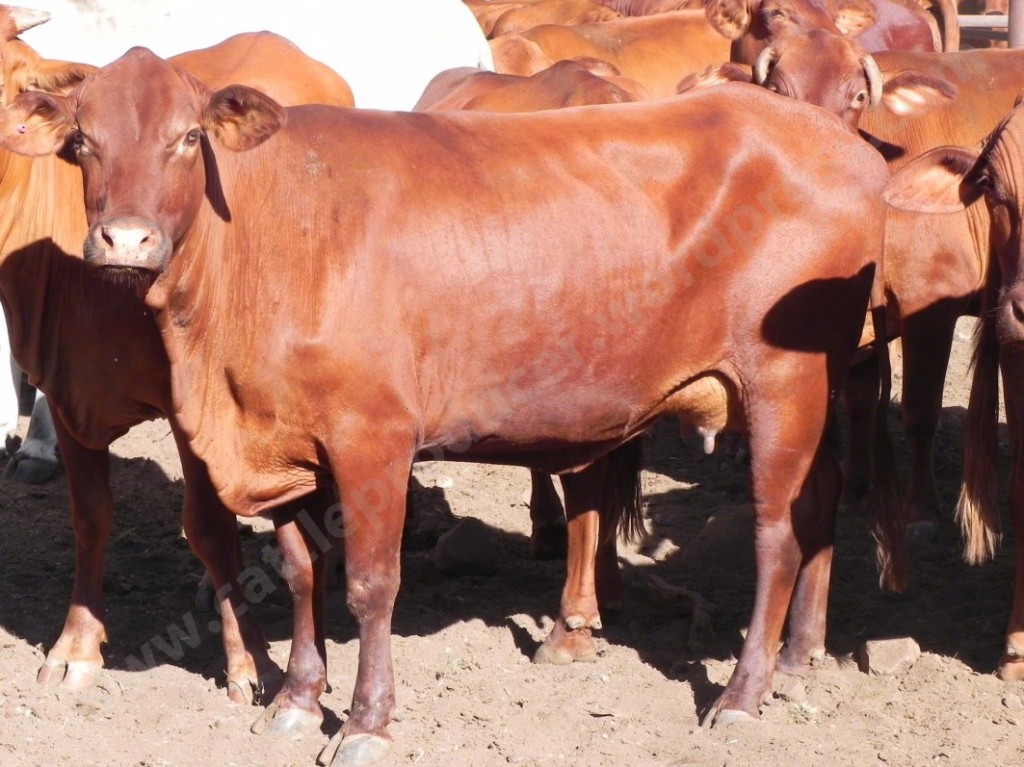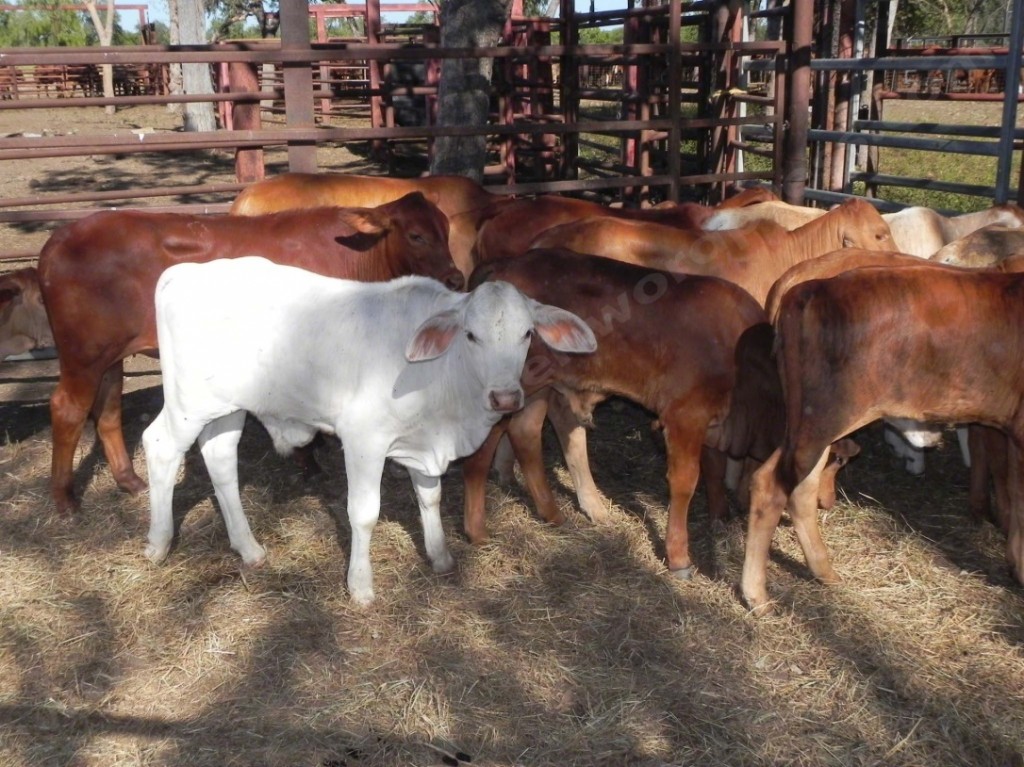Slides, gates, and dips
Host: Hodgson River Station
Written by Jo Bloomfield – Manager, Hodgson River Station.
Once we have mustered, we have the cattle in the yard now and we need to sort them out. The cattle only come into the yard once a year.
Drafting is simply the term used to sort the herd into various groups.
Bush breeders
- These are mature females and bulls that we will keep and use as the base production animals, they go back out bush. These are animals who we like physically and temperament wise and we will keep them to continue our breeding program.
- Financially these are our most important animals, they are our base herd and will determine our ongoing productivity for the years to come.
- Some of these animals are two years old right up to animals that are over ten years old. Most of our bulls are three to six years old.
 A typical Droughtmaster cow that we would keep for future production. This cow is approximately 8 years old, though starting to age she is a good type of cow with a quiet temperament, she is showing signs in her udder of milk and therefore likely we have just weaned her calf. She is obviously productively fertile, has a good frame, quiet nature, polled (no horns) and a good colour with a smooth coat. She has a medium type frame where everything looks in reasonable proportion.
A typical Droughtmaster cow that we would keep for future production. This cow is approximately 8 years old, though starting to age she is a good type of cow with a quiet temperament, she is showing signs in her udder of milk and therefore likely we have just weaned her calf. She is obviously productively fertile, has a good frame, quiet nature, polled (no horns) and a good colour with a smooth coat. She has a medium type frame where everything looks in reasonable proportion.
Truckers
- These cattle are mainly steers that are either ready for sale, over 320-350kg or animals we don’t like because of temperament or type, for instance large clean skin bulls or cows, including cows we don’t think are having calves and we term as ‘dry’. Dry cows have no milk in their udder, which means they do not have a calf on the ground, nor are they likely to be pregnant (we test them to be sure though). These animals are not productive or not the type of genetics we want in the herd.
- I will talk about Truckers specifically on day Five of the blog for Central Station
Weaners
- These are calves born since the last muster, they are unbranded, untagged, and need to removed from their mothers to allow her to maintain body condition to be ready to get pregnant again for the next season. We wean down to approximately four months of age, anything younger is put in the small calves yard.
- I will talk about Weaner handling specifically on Day Four of the blog for Central station
Small calves
- Are under four months of age, too young to be weaned but will require to be branded for identification and ownership. When branded these are immediately returned to be with their mothers.
- I will talk of the branding process in Day Four.

Drafting is done for a number of reasons.
Animal welfare
We need to vaccinate for Botulism and treat animals for ticks and buffalo flies.
- Botulism poisoning is caused by a toxin of the Clostridium botulinum organism, it occurs commonly in soil and is prevalent in areas that are phosphorus deficient, it is a terrible disease that attacks the nervous system of the animal and if acute will cause paralysis of the nerves so the animal loses all control of muscle and nerve functions.
- Due to the paralysis the tongue is also affected and can cause the animal to starve or die of thirst as the animal is unable to manipulate the tongue to drink or eat. Fortunately we have vaccinations for this now and we give the cow a needle each year. It is absolutely vital that all animals receive a vaccination for this disease as even mild inflictions of it affect general health and ability to fight off infection or ill health.
Ticks are particularly disgusting little creatures that attach themselves and gorge on the blood of the animal. If a very heavy infestation occurs some animals can become quite ill. We don’t have a large tick population but we do have them and they are very irritating to the animals therefore must be controlled to a certain degree.

- Buffalo fly was introduced to Australia in 1858. They are smaller than a house fly, persistent and hugely irritating for animals, some animals develop large sores on their bodies rubbing and trying to alleviate the itch the bugs cause. The plunge dip is able to offer relief through the chemical that we use called Tixafly.
- Drafting allows removal of dominant male cattle from the herd. If we let the herd run feral and didn’t remove some male cattle the numbers of male cattle would be so many it would be like a pack rape and assault on all female animals. As a cow comes into season, ready to be mated the numbers of male cattle would be so great they would kill many females. We keep younger females separate up to two years old to allow to grow to maturity physically before getting pregnant. If we didn’t do this the bulls would kill the majority of young heifers too. If heifers get pregnant too young then they will have nutritional and body growth problems as they are trying to develop or raise a calf while their own body is still maturing. Animals allowed to get pregnant very young tend to be stunted and have fertility problems throughout their life.
- Weaning is vital to ensure the health of the productive cow. If not weaned a cow would continue to raise the large offspring yet lose nutrition themselves due to the drag of the milk supply on their own body condition. This affects the cows own ability to withstand environmental conditions when nutrition availability of natural grasses diminishes late in the dry season.
- At times treatments for horn growths or injuries may need to be treated, these are not all that common but do happen and must be treated as soon as possible.
Drafting yards can be in various configurations, ours is a straight race draft. Animals move through a progressive number of yards which decrease in area so less numbers of animals fit in each yard. As the animals flow through these yards, gates are closed to stop the cattle back peddling and ensuring they move forward at all times. Eventually they will get to the race. A long narrow lane that allows only one animal at a time to walk and they follow each other along this. In the race are a series of gates which swing in, these are controlled by arms and depending on which gate is opened will cut off the animals movement down the race and force them to move through the gate opening. This way as the animal’s progress in the race each animal will be looked at and appraised as to where it needs to go – Bush, Trucker, Weaner, Calf. The gates can be opened and shut without even stopping the animal. Most animals are in a yard sorted before they even realize what has happened.
We like to handle about 500 head at a time, and three of us can draft usually this number in about three hours.
Once drafted we run the bush cattle back through the race and needle every one of them for their botulism vaccine.

Each animal is also bangtailed, this is where the hair is cut from the end of the tail to show the animal has been captured and needled. Bangtailing is also a great way to see if animals are missed in the paddock as a ‘long tail’ is easily distinguishable from a ‘bangtailed’. This way we can tell what cows were mustered the previous year, and who wasn’t.


Once the bush animals are processed through the dip and the small calves returned to them the bush cattle are then walked back out to their paddock and released.
The other animals sorted by drafting, truckers are also needled, bangtailed, and treated in the dip, then released into a particular paddock to stockpile for sale.
The weaners are trucked to another yard with closer access to the house to be handled.

